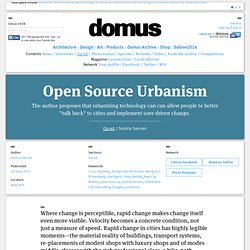

Open Source Urbanism - Op-Ed. Where change is perceptible, rapid change makes change itself even more visible.

Velocity becomes a concrete condition, not just a measure of speed. Rapid change in cities has highly legible moments—the material reality of buildings, transport systems, re-placements of modest shops with luxury shops and of modes middle-classes with the rich professional class, a bike-path where there was none—and they can be both good and not so good. Further, when rapid transformation happens simultaneously in several cities with at least some comparable conditions, it also makes visible how diverse the spatial outcomes can be even when the underlying dynamics might be quite similar.
The Future of Cities, Information, and Inclusion. Over the next decade, cities will continue to grow larger and more rapidly.

At the same time, new technologies will unlock massive streams of data about cities and their residents. As these forces collide, they will turn every city into a unique civic laboratory—a place where technology is adapted in novel ways to meet local needs. This ten-year forecast map, The Future of Cities, Information, and Inclusion, charts the important intersections between urbanization and digitalization that will shape this global urban experiment, and the key tensions that will arise.
The explosive growth of cities is an economic opportunity with the potential to lift billions out of poverty. Talking back to your intelligent city.